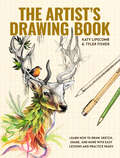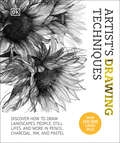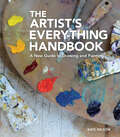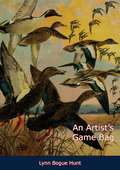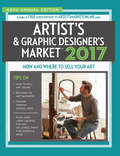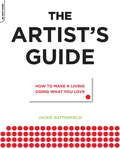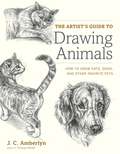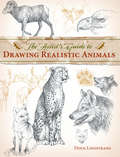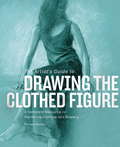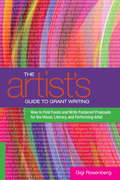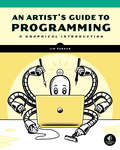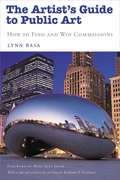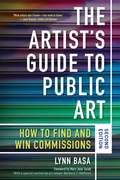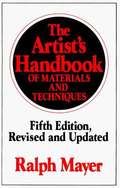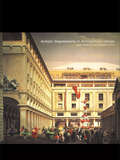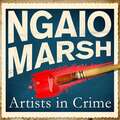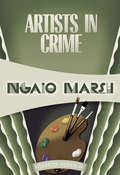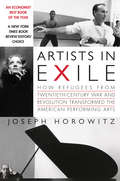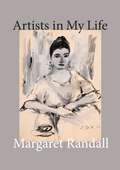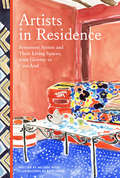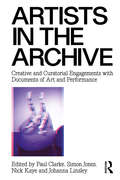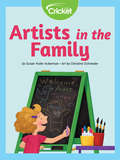- Table View
- List View
The Artist's Drawing Book: Learn How to Draw, Sketch, Shade, and More with Easy Lessons and Practice Pages
by Katy Lipscomb Tyler FisherSpark your creativity and hone your drawing skills with this comprehensive art book for beginners—which includes interactive lessons and fun practice pages!Join master artists Katy Lipscomb and Tyler Fisher as they guide you step-by-step through the art-making process. Using their Sketching Formula, anyone from beginners to experienced artists can improve their drawing abilities, expand their imagination, and achieve their creative potential. Filled with tips, tricks, and techniques, this interactive workbook guides you through a vast array of artistic approaches while inspiring your unique style.From comprehensive lessons that cover the basics of art theory to unique practice prompts that will get your creative juices flowing, The Artist's Drawing Book will teach you:• The fundamentals of art, like perspective, shading, composition, and color theory—all broken down into easy-to-digest lessons• Tips for avoiding common beginner mistakes, so you can confidently sketch any subject• Tricks for realistic texture, blending, and shading, no matter if you're working with professional-grade colored pencils or a cheap ballpoint pen• Techniques for mixing mediums so you can be limitless when creating your artwork• How to view the world like a true artist, so you can overcome creative block and find artistic inspiration wherever you go• ...and many more invaluable tips and tricks!If you're ready to start drawing as you learn how to develop your artistic abilities, The Artist's Drawing Book will encourage hands-on action to help you bring your artistic dreams to fruition.Also features:• Premium 140 gsm paper—perfect for testing out your new art skills• A sturdy hardcover with layflat design• Interactive activities so you can draw alongside each lesson• More than 200 pages of content• Over 700 inspiring illustrations• Valuable tips, tricks, and insights from the pros• Creative prompts, ideas, and inspiration• Suitable for all skill levels
Artist's Drawing Techniques: Discover How to Draw Landscapes, People, Still Lifes and More, in Pencil, Charcoal, Pen and Pastel
by DKThe ultimate complete drawing course to help you take your sketches to a higher level.Packed with inspiring workshops and advice from practicing artists, this art lesson book will help you sharpen your drawing skills in a range of media. Here&’s what you&’ll find inside the pages of this artist&’s guide to drawing: • Includes more than 90 detailed step-by-step workshops for pencil, charcoal, pen and pastel techniques • A comprehensive range of techniques makes it suitable for beginners or more experienced artists • Techniques are approached with progression in mind, so readers can learn the basics then move on to new creative challenges Every aspect of drawing is explained in incredible detail in this drawing reference guide. It starts with the basics of drawing — like learning how to draw and choosing a subject — and works all the way through to mounting your finished masterpiece. Learn more than 80 drawing techniques, from cross-hatching and stippling to blending and using colored pencils. Develop your own artistic style and grow as an artist by following the step-by-step drawing tutorials through beginner, intermediate and advanced art projects. Artist's Drawing Techniques will help you tap into your creative potential and unlock new talents, whether you&’re a complete beginner or seasoned artist.
Artists Emerging: Sustaining Expression through Drawing (Routledge Revivals)
by Sheila Paine Tom PhillipsThis title was first published in 2000. Most children enjoy drawing and use it to express a wide range of experiences and emotions. Drawing can offer an avenue of expression where words fail. So why do many people stop drawing after the early school years? This is an examination of the early work of John Everett Millais, Henri de Toulouse-Lautrec, Pablo Picasso, Michael Rothenstein, Gerard Hoffnung, Sarah Raphael and David Downes to investigate the reasons why these artists were able to sustain and develop their drawing skill and expressive potential while others failed. The close study of these artists' early drawings reveals their sequences of progress and their eventual achievement. Sheila Paine, a former President of the National Society for Education in Art and Design, shares the experience of a lifetime's work in art education to explore the mysteries of drawing fluency, its often precocious beginnings, and the personal, social and cultural circumstances which help or hinder its development.
The Artist's Everything Handbook: A New Guide to Drawing and Painting
by Kate WilsonThe Artist’s Everything Handbook is your complete guide to the fundamentals of artistic creation. Encompassing a diverse range of drawing, sketching, and painting techniques—from pen and ink to oils and acrylics—you’ll find everything you need to create daring and imaginative works of art.Divided according to medium, each section offers an informative overview and a thorough exploration of all the relevant tools and materials. Chapters suggest innovative ways to tackle your subjects, and provide specially commissioned illustrations with detailed tutorials and helpful tips. Learn how to properly mix paint colors, take a small object and scale it up, and play with the idea of positive and negative space. Inside, you’ll also find galleries of contemporary artwork that demonstrate the range of effects that can be achieved using a particular technique. Acknowledging the growing interest in digital media, this book also includes information on how certain effects can be re-created using programs such as Photoshop and drawing apps. And finally, artist profiles offer insight into the working processes of some of today’s emerging painters and drawers from all around the world.Filled with imaginative ideas and tutorials, varied and inspiring work from young contemporary artists, and a fresh, modern approach to old art forms, this book is your essential reference to dive into the boundless possibilities of drawing and painting.
An Artist’s Game Bag
by Lynn Bogue HuntAmerica’s leading bird painter has pictured every game bird, both upland, wild fowl and shore birds—including the predatory hawks and owls—found in the United States.This book not only represents a unique collection of the art of Lynn Bogue Hunt—including the finest work he has ever done—but is an ornithologically correct guide to American game birds.This superb collection is beautifully illustrated with drawings and painting.
Artist's & Graphic Designer's Market 2017 (Market #2017)
by Noel RiveraBuild a successful art career! Do you want to establish or expand a career for yourself in fine art, illustration, or design? Then Artist's & Graphic Designer's Market 2017 is the must-have reference guide you need. Thousands of successful artists have relied on us to help develop their careers and navigate the changing business landscape. The Artist's & Graphic Designer's Market 2017 introduces a whole host of new features and guarantees the most up-to-date, individually verified market contacts possible. Grow your art business with these resources:A FREE 1-year subscription to ArtistsMarketOnline.com, where you can find industry contacts, track your submissions, get the latest art and design news, and much more.Complete, up-to-date contact information for more than 1,800 art market resources, including galleries, magazines, book publishers, greeting card companies, ad agencies, syndicates, art fairs, and more.Articles on the business of freelancing--from basic copyright information to tips on promoting your work.Information on grants, residencies, organizations, publications, and websites that offer support and direction for visual artists of all types.NEW! Informative articles on the art of customer service, creating a noteworthy portfolio, protecting your intellectual property, and adding teaching to your list of freelance possibilities.NEW! Special features on maintaining your motivation as a freelancer, brand marketing, etiquette for artists, and artists' assistants.NEW! Inspiring and informative interviews with successful professionals including illustrator Peter Sis, artists Seth Lyons and Kevin T. Kelly, and concept artists Gilles Beloeil and Lauren Airriess.
The Artist's Guide: How to Make a Living Doing What You Love
by Jackie BattenfieldUsing a "tough love approach" to pursuing a career in the visual arts, Jackie Battenfield expands on her highly successful classes and workshops to provide a comprehensive guide for both emerging and mid-career artists.Providing real-life examples, illustrations, and step-by-step exercises, Battenfield offers readily applicable advice on all aspects of the job. Along with tips on planning and assessment, she presents strategies for self-management, including marketing, online promotion, building professional relationships, grant writing, and portfolio development.Each chapter ends with an insightful "Reality Check" interview, featuring advice and useful information from high-profile artists and professionals.The result is an inspiring, experiential guide brimming with field-tested techniques that readers can easily apply to their own career.
The Artist's Guide to Drawing Animals: How to Draw Cats, Dogs, and Other Favorite Pets
by J. C. AmberlynCreate Classic Portraits of Favorite PetsThe Artist's Guide to Drawing Animals continues the rich tradition of animals in art. In this step-by-step guide to rendering your favorite animals in pencil and pen-and-ink, J. C. Amberlyn combines her love of pets and other familiar domestic creatures with her beautiful, detailed drawing style. Covering a variety of animals from beloved pets like dogs and cats to barnyard critters like cows and sheep and many more, the book covers every species with easy-to-follow instructions for drawing them from every angle imaginable. Along with seven featured examinations of Amberlyn's artistic process, each chapter showcases the tools and techniques needed to produce your own highly detailed, lifelike drawings of a variety of well-known animal companions. The worlds of artists and animal lovers come together in this richly illustrated, in-depth guide to producing charming portraits of some of the most popular pets and domesticated creatures.Also available as an eBookFrom the Trade Paperback edition.
The Artist's Guide to Drawing Realistic Animals
by Doug LindstrandBreathe Life into Your Animal DrawingsWildlife artist Doug Lindstrand has spent 30+ years observing animals in nature and capturing them on paper. In this book, he distills his expertise into key lessons for drawing any animal in a charming, realistic style.Inside, a whole herd of step-by-step exercises and demonstrations (43, to be exact!) cover a broad range of subjects and challenges, including how to draw:short, long and patterned furmouths, eyes, ears and hornsvarious poses, including seated, standing and movinga diversity of animals, domestic and wild - from housecats to big cats, from tiny cottontails to massive African elephants.Nothing intimidating here! Starting with easy sketches, you'll learn to gradually refine basic shapes into lifelike dogs, wolves, deer, sheep, horses, bears, giraffes, owls, eagles, geese and other magnificent creatures. With this classic and time-tested approach, you'll be able to draw not only the animals illustrated on these pages, but any animal that touches your artistic soul.
The Artist's Guide to Drawing the Clothed Figure: A Complete Resource on Rendering Clothing and Drapery
by Michael MassenIn order to effectively draw clothing and drapery, an artist must recognize the basic shapes of clothing and how the principles of physics act upon those shapes. Beginning with the basic shapes of clothing and the anatomy of folds, and progressing to final rendering techniques of both sculpted and loose drapery on solid forms--including how motion affects wrinkles, folds, and waves, The Artist's Guide to Drawing the Clothed Figure presents a novel and completely thorough approach to understanding the mechanics of drapery. This comprehensive resource examines the mechanical principles behind the formation of folds: simple wave patterns, intersecting wave patterns, and tertiary effects upon these two, such as twisting and flowing forms. The book breaks down all clothing into three types: sculpted forms, loose drapery, and, most especially, tubes. Once these mechanics are established, various techniques for rendering clothing are presented, including how factors such as the stiffness, thickness, or texture of a particular material can affect the appearance of an article of clothing. Throughout, the author examines examples from master draftspersons--old masters, cartoonists, illustrators, and fashion illustrators, including Leonardo da Vinci, Ingres, Degas, Joseph Christian, Leyendecker, Charles Dana Gibson, Raphael, and Will Eisner--to see how they interpreted this information.From the Hardcover edition.
The Artist's Guide to GIMP, 2nd Edition: Creative Techniques for Photographers, Artists, and Designers
by Michael HammelAs a full-featured, free alternative to Adobe Photoshop, GIMP is one of the world's most popular open source projects. The latest version of GIMP (2.8) brings long-awaited improvements and powerful new tools to make graphic design and photo manipulation even easier—but it's still a notoriously challenging program to use.The Artist's Guide to GIMP teaches you how to use GIMP without a tedious list of menu paths and options. Instead, as you follow along with Michael J. Hammel's step-by-step instructions, you'll learn to produce professional-looking advertisements, apply impressive photographic effects, and design cool logos and text effects. These extensively illustrated tutorials are perfect for hands-on learning or as templates for your own artistic experiments.After a crash course in GIMP's core tools like brushes, patterns, selections, layers, modes, and masks, you'll learn:–Photographic techniques to clean up blemishes and dust, create sepia-toned antique images, swap colors, produce motion blurs, alter depth of field, simulate a tilt-shift, and fix rips in an old photo–Web design techniques to create navigation tabs, icons, fancy buttons, backgrounds, and borders–Type effects to create depth, perspective shadows, metallic and distressed text, and neon and graffiti lettering–Advertising effects to produce movie posters and package designs; simulate clouds, cracks, cloth, and underwater effects; and create specialized lightingWhether you're new to GIMP or you've been playing with this powerful software for years, you'll be inspired by the original art, creative photo manipulations, and numerous tips for designers.Covers GIMP 2.8
The Artist's Guide to Grant Writing: How to Find Funds and Write Foolproof Proposals for the Visual, Literary, and Performing Artist
by Gigi RosenbergThe Artist's Guide to Grant Writingis designed to transform readers from starving artists fumbling to get by into working artists who confidently tap into all the resources at their disposal. Written in an engaging and down-to-earth tone, this comprehensive guide includes time-tested strategies, anecdotes from successful grant writers, and tips from grant officers and fundraising specialists. The book is targeted at both professional and aspiring writers, performers, and visual artists who need concrete information about how to write winning grant applications and fundraise creatively so that they can finance their artistic dreams.
An Artist's Guide to Programming: A Graphical Introduction
by Jim ParkerLearn to program with visual examples. Programs increase in complexity as you progress — from drawing a circle to 3D graphics, animations, and simulations.A Graphical Introduction to Programming teaches computer programming with the aid of 100 example programs, each of which integrates graphical or sound output. The Processing-language-based examples range from drawing a circle and animating bouncing balls to 3D graphics, audio visualization, and interactive games. Readers learn core programming concepts like conditions, loops, arrays, strings and functions, as well as how to use Processing to draw lines, shapes, and 3D objects. They&’ll learn key computer graphics concepts like manipulating images, animating text, mapping textures onto objects, and working with video. Advanced examples include sound effects and audio visualization, network communication, 3D geometry and animation, simulations of snow and smoke, predator-prey populations, and interactive games.
The Artist's Guide to Public Art: How to Find and Win Commissions
by Lynn BasaPublic art commissions--how to find them, how to get them. * First-hand advice from experienced public artists* Written by an artist for artists* Includes expert information on public art law Learn how to find, apply for, compete for, and win a public art commission. First-hand interviews with experienced public artists and arts administrators provide in-the-trenches advice and insight, and a chapter on public art law, written by Barbara Hoffman, the country''s leading public art law attorney, answers questions about this complex area. Packed with details on working with contracts, conflict, controversy, communities, committees, and more, "The ArtistOCOs Guide to Public Art "shows artists the way to cut through the red tape and win commissions that are rewarding both financially and artistically. "
The Artist's Guide to Public Art: How to Find and Win Commissions (Second Edition)
by Lynn Basa“What artists don’t know—but need to know.” —Jack Becker, Public Art ReviewA Comprehensive Guide to the Complex World of Public ArtLearn how to find, apply for, compete for, and win a public art commission. First-hand interviews with experienced public artists and arts administrators provide in-the-trenches advice and insight, while a chapter on public art law, written by Barbara T. Hoffman, the country's leading public art law attorney, answers questions about this complex area. Packed with details on working with contracts, conflict, controversy, communities, committees, and more, The Artist's Guide to Public Art, Second Edition, shows artists how to cut through the red tape and win commissions that are rewarding both financially and artistically. This new edition discusses recent trends in the field, such as: how the political climate affects public art, the types of projects that receive funding, where that funding comes from, how the digital age impacts public art, how to compete with the increase of architecturally trained artists, and more. Written by an artist, for artists, this guide is packed with everything readers need to know:Finding commissionsSubmitting applicationsNegotiating contractsBudgeting for projectsNavigating copyright lawWorking with fabricatorsAnd much moreFrom start to finish, Lynn Basa covers all the steps of the process. With The Artist's Guide to Public Art, Second Edition, even readers without prior experience will be more than ready to confidently pursue their own public art projects.
The Artist's Handbook Of Materials And Techniques (Reference)
by Ralph MayerThe Artist's Handbook of Materials and Techniques is a reference book by Ralph Mayer (1895–1979). Intended by the author for use by professional artists, it deals mostly with the chemical and physical properties of traditional painterly materials such as oil, tempera, and encaustic, as well as solvents, varnishes, and painting mediums. It also has extensive coverage of ancillary activities such as stretching and preparing canvas, care and maintenance of tools, and conservation of older paintings. Originally published in 1940, the Handbook was referred to as "the painter's bible" at the time,[citation needed] and it continues to have a place on the reading list in American universities to this day. It underwent three extensive revisions in Mayer's lifetime, and the fifth posthumous edition is still in print. Ralph Mayer’s archives of writing and research on materials and techniques are now at the Ralph Mayer Learning Center, Yale University School of Art.
Artists' Impressions in Architectural Design: Null
by Bob Giddings Margaret HorneArtists' Impressions in Architectural Design analyses the ways in which architects have presented their designs for clients and the public, both historically and contemporarily. It spans a period from the fifteenth to the twenty-first century.Architects have become familiar with change. The passage of time has brought with it new and revived styles of architecture, as well as innovative tools and techniques for their representation. The result is that while some methods show a view of the architect's concept for a building, others offer an almost real experience of the intended architecture. This book provides a rare and valuable study in which the exciting technological developments of today are placed in context with the rich heritage of the past. It offers an opportunity to learn how architects have chosen to represent their ideas. The authors dare to glimpse into the future and hopefully offer some reassurance for tomorrow.
Artists In Crime (Inspector Alleyn #34)
by Ngaio MarshWhen murder upsets the creative tranquility of an artists' colony, Scotland Yard sends in its most famous investigator. And what begins as a routine case turns out to be the most momentous of Roderick Alleyn's career. For before he can corner the killer, his heart is captured by one of the suspects - the flashing-eyed painter Agatha Troy, who has nothing but scorn for the art of detection....Artists in Crime was first published in 1938.
Artists in Crime: Death In Ecstasy, Vintage Murder, Artists In Crime (Roderick Alleyn #6)
by Ngaio MarshA model is murdered in this &“first-rate&” detective story by the Mystery Writers of America Grand Master (Kirkus Reviews). On a ship traveling back to England, Miss Agatha Troy finds Inspector Roderick Alleyn tedious and dull; he thinks she&’s a bohemian cliché. They may be destined for romance, but there&’s a murder in the way: No sooner has Alleyn settled in to his mother&’s house, eager for a relaxing end to his vacation, than he gets a call that a model has been stabbed at the artists&’ community down the road. And the talented Miss Troy is one of the community&’s most prominent and outspoken members . . . &“The doyenne of traditional mystery writers.&” —The New York Times
Artists in Exile
by Joseph HorowitzDuring the first half of the twentieth century--decades of war and revolution in Europe--an "intellectual migration" relocated thousands of artists and thinkers to the United States, including some of Europe's supreme performing artists, filmmakers, playwrights, and choreographers. For them, America proved to be both a strange and opportune destination. A "foreign homeland" (Thomas Mann), it would frustrate and confuse, yet afford a clarity of understanding unencumbered by native habit and bias. However inadvertently, the condition of cultural exile would promote acute inquiries into the American experience. What impact did these famous newcomers have on American culture, and how did America affect them? George Balanchine, in collaboration with Stravinsky, famously created an Americanized version of Russian classical ballet. Kurt Weill, schooled in Berlin jazz, composed a Broadway opera. Rouben Mamoulian's revolutionary Broadway productions of Porgy and Bess and Oklahoma! drew upon Russian "total theater." An army of German filmmakers--among them F. W. Murnau, Fritz Lang, Ernst Lubitsch, and Billy Wilder--made Hollywood more edgy and cosmopolitan. Greta Garbo and Marlene Dietrich redefined film sexuality. Erich Korngold upholstered the sound of the movies. Rudolf Serkin inspirationally inculcated dour Germanic canons of musical interpretation. An obscure British organist reinvented himself as "Leopold Stokowski." However, most of these gifted émigrés to the New World found that the freedoms they enjoyed in America diluted rather than amplified their high creative ambitions.A central theme of Joseph Horowitz's study is that Russians uprooted from St. Petersburg became "Americans"--they adapted. Representatives of Germanic culture, by comparison, preached a German cultural bible--they colonized. "The polar extremes," he writes, "were Balanchine, who shed Petipa to invent a New World template for ballet, and the conductor George Szell, who treated his American players as New World Calibans to be taught Mozart and Beethoven." A symbiotic relationship to African American culture is another ongoing motif emerging from Horowitz's survey: the immigrants "bonded with blacks from a shared experience of marginality"; they proved immune to "the growing pains of a young high culture separating from parents and former slaves alike."
Artists in My Life
by Margaret RandallMargaret Randall reveals personal stories and profound insights about the artists who most influenced her life.Artists in My Life is a collection of intimate and conversational accounts of the visual artists that have impacted the renowned poet activist Margaret Randall on her own journey as an artist. Randall writes of each relationship through multiple lenses: as makers of art, social commentators, women in a world dominated by male values, and in solitude or collaboration with communities and the larger artistic arena. Each story offers insight into the artist’s life and work, and analyses the impact it had on Randall’s own work and its impact on the larger art community. The work strives to answer bigger questions about visual art as a whole and its lasting political influence on the world stage. Randalls describes her motivations: ”I go beneath the surface, asking questions and telling stories. I have wanted to answer questions such as: Why is it that visual art—drawing, painting, sculpture, photography, architecture—grabs me and, in particular instances, feels as if it changes me at the molecular level? How do art and memory interact? How do reason and intuition come together in art? Do women and men make art differently? Does great art change the viewer? Does it change the artist? How does art travel through time?”
Artists in Offices: An Ethnography of an Academic Art Scene
by Judith E. AdlerUniversities have become important sources of patronage and professional artistic preparation. With the growing academization of art instruction, young artists are increasingly socialized in bureaucratic settings, and mature artists find themselves working as organizational employees in an academic setting. As these artists lose the social marginality and independence associated with an earlier, more individual aesthetic production, much cultural mythology about work in the arts becomes obsolete.This classic ethnography, based on fieldwork and interviews carried out at the California Institute of the Arts in the 1980s, analyzes the day-to-day life of an organization devoted to work in the arts. It charts the rise and demise of a particular academic art "scene," an occupational utopian community that recruited its members by promising them an ideal work setting.Now available in paperback, it offers insight into the worlds of art and education, and how they interact in particular settings. The nature of career experience in the arts, in particular its temporal structure, makes these occupations particularly receptive to utopian thought. The occupational utopia that served as a recruitment myth for the particular organization under scrutiny is examined for what it reveals about the otherwise unexpressed impulses of the work world.
Artists in Residence: Seventeen Artists and Their Living Spaces, from Giverny to Casa Azul
by Melissa WyseArtists in Residence explores the homes of 17 legendary and contemporary artists.Readers can peek inside Georgia O'Keeffe's adobe courtyards, stroll through Henri Matisse's vibrant aviary, and peruse Jean-Michel Basquiat's collection of over 1,000 videotapes.A house or an apartment is not simply a place to eat and sleep for these artists; they transform quotidian spaces into dynamic reflections of their individual artistic preoccupations.• Offers a fascinating and inspiring blend of art history, interior design, and travel• Invites readers to peer behind the closed doors of top artists from around the world• Richly illustrated throughoutThrough vivid text and image, Artists in Residence explores how each artist's living space relates to their individual and distinct artist practice.Readers gain a deeper appreciation of their favorite artists' work, and perhaps discover a new favorite visual along the way.• This petite jacketed hardcover book makes a wonderful gift for artists and art fans everywhere.
Artists in the Archive: Creative and Curatorial Engagements with Documents of Art and Performance
by Paul Clarke Simon Jones Nick Kaye Johanna LinsleyArtists in the Archive explores the agency and materiality of the archival document through a stunning collection of critical writings and original artworks. It examines the politics and philosophy behind re-using remains, historicising this artistic practice and considering the breadth of ways in which archival materials inform, inflect and influence new works. Taking a fresh look at the relationships between insider know-how and outsider knowledge, Artists in the Archive opens a vital dialogue between a global range of artists and scholars. It seeks to trouble the distinction between artistic practice and scholarly research, offering disciplinary perspectives from experimental theatre, performance art, choreography and dance, to visual art making, archiving and curating.
Artists in the Family
by Susan Yoder AckermanAunt Tonya is coming to visit! Viv wants to surprise her with a drawing, but she doesn’t think she is very good at art. Together with her brother, Emmett, they plot to create a map of memories and take Aunt Tonya on an adventure! Along the way, Viv discovers that perhaps she is an artist, after all!
